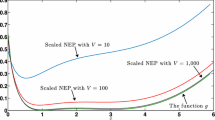Abstract
By observing that the n-tuple of rate functionsQ(c) is orthogonal to the c-space gradients of each of the (n - 1) constants of the motion Φ v (c), a generic canonical expression for the rate functions is given in terms of the exterior product of the gradients of the (n - 1) Φ v 's. For models withQ so prescribed from the outset, an analytical general solution is obtainable directly for the system of autonomous ordinary differential equations dc/dt =Q(c). Thus, the generic canonical expression for the rate functions can be utilized to construct analytically solvable models for interacting biological species, as ilIus~rated by examples here.
Similar content being viewed by others
Literature
Balslev, I. and H. Degn. 1975. “Spatial Instability ill Simple Reaction Schemes.”J. Theor. Biol.,49, 173–177.
Courant, R. and D. Hilbert. 1962.Methods of Mathematical Physics, Vol. 2, pp. 28–32. New York: Wiley-Interscience.
Freedman, H. I. 1975. “A Perturbed Kolmogorov-Type Model for the Growth Problem.”Math. Biosci.,25, 127–149.
León, J. A. and D. B. Tumpson. 1975. “Competition between Two Species for Two Complementary or Substitutable Resources.”J. Theor. Biol.,50, 185–201.
May, R. M. 1971. “Stability in Multispecies Community Models.”Math. Biosc.,12, 59–79.
———. 1972. “Limit Cycles in Predator-Prey Communities.”Science,177, 900–902.
Maynard-Smith, J. 1974.Models in Ecology. Cambridge University Press: London.
Montroll, E. W. 1968. “Lectures on Nonlinear Rate Equations, Especially Those with Quadratic Nonlinearities.” InLectures in Theoretical Physics, Barut, A. O. and W. E. Britton, eds., pp. 531–573. New York: Gordon and Breach.
Rapp, P. E. 1975. “Biochemical Oscillators-A Search Procedure.”Math. Bioaci.,23, 289–303.
Rescigno, A. and K. G. Jones. 1972. “The Struggle for Life: III. A Predator-Prey Chain.”Bull. Math. Biophys.,34, 521–532.
Rescigno, A. and I. W. Richardson. 1967. “The Struggle for Life: I. Two Species.”Bull. Math. Biophys.,29, 377–388.
Rosenzweig, M. L. 1971. “Paradox of Enrichment: Destabilization of Exploitation Ecosystems in Ecological Time.”Science,171, 385–387.
Strickfaden, W. B. and B. A. Lawrence. 1975. “Solvable Limit Cycle in a Volterra-Type Model of Interacting Populations.”Math. Biosci.,23, 273–279.
Thornton, K. W. and R. J. Mulholland. 1974. “Lagrange Stability and Ecological Systems.”J. Theor. Biol.,45, 473–485.
Utz, W. R. 1961. “The Equations of Population Growth.”Bull. MaSh. Biophys.,23, 261–262.
Utz, W. R. 1963. “Periodicity and Boundedness of Solutions of Generalized Differential Equations of Growth.”Bull. Math. Biophys.,25, 75–93.
Author information
Authors and Affiliations
Rights and permissions
About this article
Cite this article
Rosen, G. Construction of analytically solvable models for interacting species. Bltn Mathcal Biology 38, 193–197 (1976). https://doi.org/10.1007/BF02471755
Issue Date:
DOI: https://doi.org/10.1007/BF02471755




